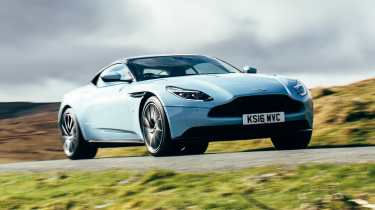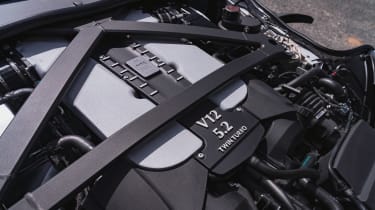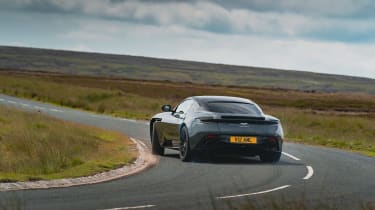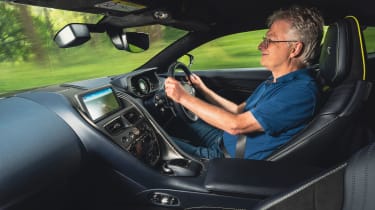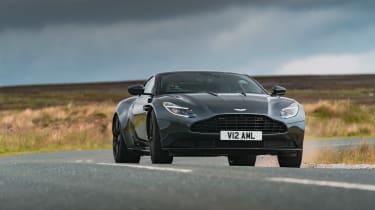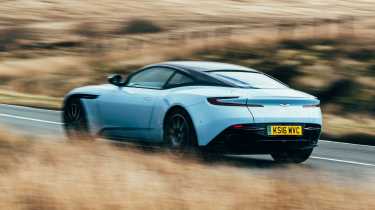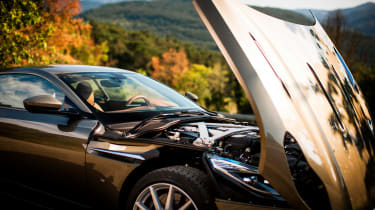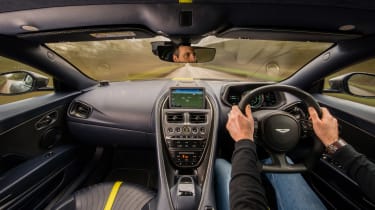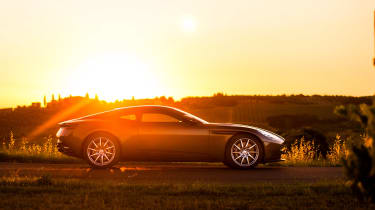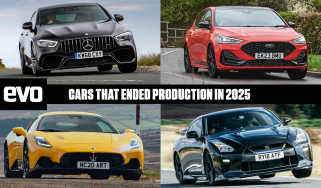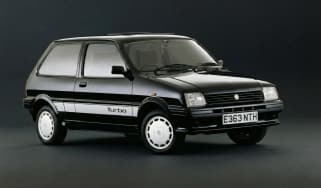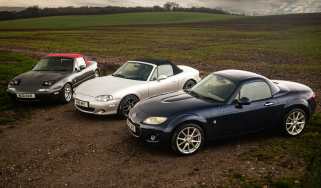Aston Martin DB11 (2016 - 2023) review – Aston’s last mainstream V12 for Cayman money
Aston’s almost forgotten V12-engined GT was flawed on its introduction but looks like great value for what they’re worth today
One of the many moments of rebirth for Aston Martin came in 2016 with the introduction of the DB11. This was the first all-new road car of the Andy Palmer era and the first to use the VH-II architecture, taking over from the first iteration of the bonded extruded structure that was introduced with the DB9 in 2003.
But optimism for a bright new era was short-lived. Stagnant sales, quality control issues, over-expenditure and a disastrous floating on the stock market lead to Palmer’s departure and indeed, proved challenging for a succession of individuals. Only now under the leadership of Lawrence Stroll and with ex-Bentley man Adrian Hallmark at the helm has Aston’s product lineup (if not yet its profit reports) met and at times exceeded the expectations we first had of the DB11 all those years ago.
That's not to say the DB11 wasn't a good car. It was a great GT and a worthy next step for Aston Martin at the time, if not the quantum leap we all expected. And as is often the case with Aston’s middling DB models, it never nailed any one of the many tasks it could turn a reasonably talented hand to. It did improve over the years, however, with the V8 model being more agile thanks to its lighter weight and the AMR version adding focus to the V12 model.
More reviews
As is also often the case, the DB11’s appeal is quietly rising as it ages and depreciates. You can now pick up Aston’s last mainline GT with a V12 engine for middling Porsche Cayman money.
Engine, gearbox and technical highlights
- First appearance of Aston’s 5.2-litre V12, with AMG’s V8 joining later
- First use of the ‘VH-II’ aluminium architecture
- Lighter V8 takes it under 1800kg
The DB11 came in both V8 and V12 flavours. Like the Vantage, DBX and the new DB12, the base DB11’s 4-litre twin-turbo V8 is the same M177 AMG unit that features in a big cross section of AMG models. While it may sound a tad less exotic than the V12, if you’re going to share an engine with someone, it might as well be the best, and AMG’s V8 is close to it.
Power was modulated from the original’s 503bhp to 528bhp which was a unique rating within the Aston Martin and AMG ranges. Even with the extra grunt, the V8 feels under-stressed and good for its claimed performance figures, with its 498lb ft of torque peaking at just 2000rpm.
The V12 is all Aston Martin by comparison. It’s a bespoke twin-turbo, all-alloy, quad-cam, 48-valve, 5.2-litre V12 that later saw service in the DBS Superleggera, V12 Vantage, V12 Speedster and Valour. In the DB11 it had 600bhp and 516lb ft but power eventually rose to 630bhp with the introduction of the DB11 AMR, that eventually became the standard DB11 – a big on-paper jump over the V8 models either way.
In order to keep in compliance with increasingly stringent emissions regulations, the V12 has cylinder deactivation (Intelligent Bank Activation in Aston speak) and stop-start. Adjustment of the DB11’s damping, steering and engine mapping comes through the driving modes, ranging from GT, through Sport and Sport+. These can be mixed and matched with individual settings.
Drive on all models is sent to the rear wheels via ZF’s ubiquitous but very good eight-speed automatic gearbox. Unusually, the gearbox is mounted on the rear axle for a typical GT-like weight distribution, and the prop shaft is made of carbonfibre to keep the driveline as free of inertia as possible. There is also a mechanical limited-slip diff, and active torque vectoring using the brakes, which are iron as standard.
| Lexus LC 500 | Ferrari Roma | Bentley Continental GT V8 | Aston Martin DB11 AMR | |
|---|---|---|---|---|
| Engine | V8, 4969cc | V8, 3855cc, twin-turbo | V8, 3993cc, twin-turbo | V12, 5204cc, twin-turbo |
| Power | 470bhp @ 7100rpm | 611bhp @ 5750rpm | 542bhp @ 6000rpm | 630bhp @ 6500rpm |
| Torque | 398lb ft @ 4800rpm | 560lb ft @ 3000-5750rpm | 568lb ft @ 2000-4500rpm | 516lb ft @ 1500-5000rpm |
| Weight | 1935kg | 1570kg | 2165kg | 1795kg |
| Power-to-weight | 247bhp/ton | 395bhp/ton | 254bhp/ton | 357bhp/ton |
| 0-62mph | 4.7sec | 3.4sec | 4.0sec | 3.7sec |
| Top speed | 168mph | 199mph+ | 198mph | 208mph |
Aston Martin’s VH-II aluminium platform underpins the DB11 alongside the DBS and Vantage. This bonded and riveted structure remains stiffer and lighter than a traditional aluminium one, being inspired by Lotus. The DB11 had a 65mm longer wheelbase and shorter overhangs than the DB9 it replaced.
Connected to this underlying structure is a double wishbone suspension set-up on all four corners, giving the DB11 excellent wheel travel and an excellent base to tune the standard adaptive dampers and coil springs. There’s no air springs or active anti-roll systems here like you’ll find in a Bentley Continental GT as there’s just not enough mass to require it.
Performance ride and handling
- More GT car than b-road crushing sports car…
- … but still more engaging than an equivalent Bentley
- Mightily quick either way
The DB11 is a quick car in all its forms, thanks to a consistent combination across the engine range of big torque figures and the sharp-shifting transmission. The entry-level V8 coupe hits 62mph in just 4.0sec, which might only make it a shade quicker on paper than a 992 911 Carrera, but it’s more than fast enough to never feel anything less than unstressed on the road. Thanks to the hot-V turbo layout, the power unit picks up with incredible ease in the mid-range, giving the DB11 an impressive surge of acceleration no matter the situation.
The V12-powered AMR is unsurprisingly the quicker car, reaching 62mph in 3.7sec, but the difference at road speeds compared to the V8 is less pronounced. That’s because while the AMR has a chunky 102bhp power advantage, torque is only marginally up by 18lb ft, a figure further blunted by the AMR’s slight increase in weight. While the AMR does bring chassis tweaks to make it more dynamically accomplished and engaging, the V12 and transmission also feature revised calibration and delivery – it’s a smoother experience than early V12s.
While the mid-range is where you have to live to get the best from it, the upper echelons of the rev band are still worth explorine, while eliciting that trademark Aston Martin bark. In fact, the car is far louder outside the cabin than in. The V12 is mightily performant and really gets into its stride around 4000rpm.
The DB11 is most definitely a GT car. There’s plenty of depth in the suspension travel, which gives it a wonderfully relaxed feeling over bigger bumps. It makes the DB11 a very nice place to do a long journey in, which is right on target for its GT mantra. Despite this focus, the DB11 still has that underlying quality of engineering and set-up defined by Matt Becker-era Astons, meaning it doesn’t wilt when the roads get challenging.
The steering is surprisingly quick, and the inherent balance of the chassis is tenable. Throw the DB11 into a fast corner and you get this wonderful feeling of the car leaning into its outside rear wheel and encouraging you to get on the throttle early to drive hard through a corner. It really does inspire confidence, and even over the limit never feels as intimidating as the car’s size or price might infer.
Push the front end hard on a slightly tighter road and you will hear the front tyres chirrup as they reach their limits, but the long nose never washes out indiscriminately. There isn’t a great deal of feel through the steering, but it is accurate and there’s a definite sense of solidity and connection that allows you to push the big car surprisingly hard.
Only on a bumpy British B-road does the DB11 feel less happy being hustled because although the fundamental balance remains, the rapid-fire nature of the bumps means the damping doesn’t always have time to really control the long travel between hits. Because it’s not ruthlessly tied down it can also feel a little floaty as it moves through its suspension on turn-in; not something that the altogether tighter, more aggressive DB12 suffers with. The flip side is that some might prefer the DB11's more relaxing demeanour during day-to-day use.
It can often feel tempting to downshift an extra gear on the way into a corner, but you’re better off leaning on the V12’s readily available mid-range torque and leaving yourself more headroom with the revs as the V12 doesn’t have an expansive top end to reach into like the naturally aspirated cars of old. Move up to the Sport or Sport Plus settings and the exhaust note comes alive, too. The double glazing muffles the sound a bit inside the car (as it’s meant to) but the soundtrack is most definitely distinctly Aston, despite the addition of the turbochargers.
The V8 model by comparison trades on a finer balance; with less mass in front of the driver to manage, it turns in with a little more enthusiasm and verve, even if the grip levels are mostly even.
In any form, the DB11 is a rather lovely thing. In our experiences, it’s proved a great car for eating the miles across Britain, France, Belgium, Germany, Switzerland and Italy and was then very enjoyable on the more flowing roads of Tuscany when we got there. Tighter, bumpier roads are not really its thing, but that’s fine. The DB11 is the GT, and when it comes to fitness for purpose none hits quite the same notes in quite the same way.
Aston Martin DB11 (2017)
‘Its loping, long-travel feel is far more suited to graceful, smooth progress on undulating or unwrinkled surfaces than the staccato lumps and ridges of British B-roads. We’d also prefer to stack a little more of the V12’s torque higher in the rev range, as in mixed conditions you can often feel the rear axle drive into the traction control, but overall Aston’s first twin-turbo is a peach.’ – David Vivian.
Aston Martin DB11 AMR (2020)
‘Instead of snatching and rolling awkwardly in random directions, the sudden arrival of torque amplifying an already precarious situation, the AMR is vastly more transparent. It relinquishes grip early, but it’s no longer scary – it’s actually enjoyable, communicating clearly to the driver. Stay within the limits signposted through the steering and the seat’s squab and you can crack along at real pace; neat, tidy, in control – unthinkable before.’ – Adam Towler
MPG and running costs
- 20mpg on a good day
- £195 to tax if your DB11 is from April 2017 onwards
- Early cars had quality control issues, infotainment can be glitchy
Fuel consumption is never a strong point for any traditional grand tourer and the DB11 is no different – this is a thirsty car on and off paper. The DB11 V12 returns between 18 and 22mpg on the WLTP cycle, dropping fiercely into the teens when pushed. CO2 has also been reduced, though this won’t make a huge amount of difference if your chosen car is post-April 2017 with a £195/year flat rate.
The V8 model can lift efficiency up to 24mpg, which is a realistic figure only for gentle motorway driving. The realities of Aston Martin ownership may not be cheap, but then it is not really any worse than competitors, with the Bentley Continental GT Speed of the time still only registering a similar 18-22mpg. Servicing, too, will be relatively expensive if you’re trading up from something a little less grand.
As for issues, no catastrophic problems have yet been reported with Aston Martin DB11s. Quality control niggles did plague this era of Astons, however, from panel fitment to infotainment issues. The former should be obvious to see from the outside but the latter may haunt your chosen car after you’ve bought it. Be sure to check bodywork aero channels for detritus and blockages too – from the coupe window through to the spoiler, as well as the vents ahead of the front wheels. The latter famously means the side of a DB11 rarely stays clean.
Both the V12 and V8 are generally solid but nonetheless, immaculate service and MOT history, and a multi-point pre-purchase inspection are advised. Buying approved used or from a specialist should give peace of mind about your chosen DB11.
Interior and tech
- Cabin dated when new, moreso now...
- ... albeit still with an air of artisanal luxury
- More cramped than a Bentley Continental GT
The interior’s design was a little lacklustre when new, so looks fairly ancient now. While lacking Bentley glamour, the was closing in on five generations behind the Mercedes systems of the time. Now, in hindsight? Its antiquity is less glaring. It’s an old car with old tech.
The DB11 also lacked much in the way of basic modern equipment, with no head-up display or adaptive headlights. But what the Aston offered in place of modern accoutrements was a hand-built feeling, and indeed the choice to be able to specify your car exactly as you wanted it.
Many early press-car examples of DB11 and Vantage were specified to show off the sheer level of personalisation options available, climaxing perhaps in the DB11 V8 we first drove back in 2018 which paired a metallic white exterior with a deep purple leather finish contrasted with violent pink stitching.
Aston Martin DB11 values and rivals
The DB11 never caught the wrath of Ferrari’s F12 or 812 as direct rivals, rather the considerably less daunting prospect of facing off against the California T and Portofino. The Roma’s arrival in 2020 gave Aston something to think about, though the improved DB11 AMR was already there to meet it.
A Bentley Continental GT, whether in Speed or V8 spec, was always a firm alternative to the DB11 – less dynamic but a much more practical and accomplished long-distance GT. A choice between the two was a matter of working out your priorities.
A left-field alternative we once compared the DB11 with was the Lexus LC. While this Japanese coupe was actually more of a Mercedes SL/BMW 8-series alternative, its awestriking looks and sumptuous cabin afforded it licence for comparison with the big boys. It’s a car we’d still consider a viable alternative to the Aston today, if badge kudos is low on your list of priorities. There's always competition from within, too. A late DB9 GT is a lovely car, as is a second-generation Vanquish, though neither have as rounded a skillset as a nice DB11.
Early DB11s are now out there for in the region of £60,000. The V8 was an ‘entry level’ model but arrived later in 2017, so prices start higher, in the £65k range. The DB11 of choice though, that enjoys both the elevated status of having a V12 and the best possible dynamics, is the AMR. Arriving first in 2018, these are now available from £75k and would be our pick. A 630bhp V12 super GT for Cayman GTS money? Sounds appealing to us.
Specs
| Aston Martin DB11 | Aston Martin DB11 V8 | Aston Martin DB11 AMR | |
|---|---|---|---|
| Engine | V12, 5204cc, twin-turbo | V8, 3982cc, twin turbo | V12, 5204cc, twin-turbo |
| Power | 600bhp @ 6500rpm | 528bhp @ 6000rpm | 630bhp @ 6500rpm |
| Torque | 516lb ft @ 1500rpm | 498lb ft @ 2000rpm | 516lb ft @ 1500rpm |
| Weight | 1870kg | 1760kg | 1795kg |
| Power-to-weight | 326bhp/ton | 303bhp/ton | 357bhp/ton |
| 0-62mph | 3.9sec | 4sec | 3.7sec |
| Top Speed | 200mph | 187mph | 208mph |
| Price new | £154,900 | £144,900 | £174,995 |
| Value now | From £60k | From £65k | From £75k |
